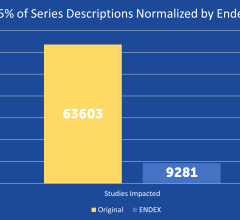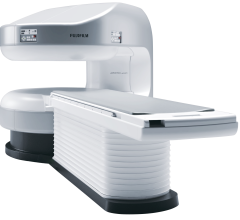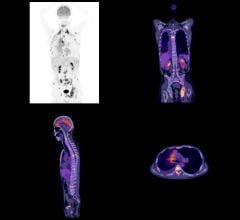October 3, 2017 — The latest release of RamSoft PowerServer, version 6.0, offers improvements to the Peer Review feature ...
October 3, 2017 – Medical Metrics, an experienced core laboratory for multi-center clinical trials, has implemented the ...
A battle is raging in imaging IT today. Once a profitable hunting ground for traditional picture archiving and communication system (PACS) firms, new market entrants from the content management, archiving and informatics market are looking to disrupt the status quo. Pushing “deconstruction,” “reconstruction” and “distributed” multi-vendor imaging IT models, they have grabbed the attention of healthcare providers.
Fujifilm’s APERTO Lucent is a 0.4T mid-field, open MRI system addressing today’s capability and image quality needs ...
Wide bore magnetic resonance imaging (MRI) systems have allowed radiologists to offer patients the optimized comfort of conventional open bore systems, as well as the high-quality imaging of conventional closed bore systems. Because wide bore MRIs have broadened the demographic of patients who can be tested, the systems have gained widespread adoption, with many practices opting to equip their offices solely with wide bore systems.
With healthcare costs constantly on the rise, technology constantly progressing and new legislative and competitive threats always on the horizon, many facilities have had to place increased emphasis on operational efficiencies. For the staff at Makati Medical Center, a large hospital in the Manila metro area of the Philippines, a multitude of costly inefficient practices — including material waste and improper vetting of products —prompted the decision to seek out a better solution.

SPONSORED CONTENT — Fujifilm’s latest CT technology brings exceptional image quality to a compact and user- and patient ...
It is once again October, Breast Cancer Awareness Month. The American Cancer Society (ACS) estimates that about 252,710 new cases of invasive breast cancer and 63,410 new cases of carcinoma in situ (CIS) will be diagnosed in 2017. About 40,610 women will die from breast cancer this year.
SPONSORED CONTENT — Fujifilm’s latest CT technology brings exceptional image quality to a compact and user- and patient ...
Thirty radiologists from seven of Strategic Radiology’s 26 member practices will contribute to work undertaken by the Watson Health Medical Imaging Collaborative to advance natural language processing capabilities used in future cognitive medical imaging solutions. The radiologists will provide expert annotation of de-identified medical images that will be used by IBM to train Watson to recognize various medical imaging terms that would be found in a patient’s electronic medical record (EMR), as well as providing feedback on solution design.
Healthcare providers now have access to fast and safe emergency department (ED) computed tomography (CT) imaging with enhancements to the Aquilion One/Genesis Edition from Toshiba Medical, a Canon Group company. The enhancement to the premium CT system now offers Model-Based Iterative Reconstruction (MBIR), which significantly improves low-contrast detectability and high-contrast spatial resolution with Toshiba Medical’s FIRST MBIR, as well as workflow and efficiency tools.
SPONSORED CONTENT — EnsightTM 2.0 is the newest version of Enlitic’s data standardization software framework. Ensight is ...
Hologic Inc. announced that Steve MacMillan, the company's chairman, president and CEO, joined selected employees to ring the Nasdaq Opening Bell on October 2 in conjunction with the start of Breast Cancer Awareness Month. This is the 12th consecutive year Hologic rang the bell for Breast Cancer Awareness Month.
Siemens Healthineers debuted the Magnetom RT Pro edition of Magnetom Vida, a version of the company’s 3T magnetic resonance imaging (MRI) scanner designed for radiation therapy (RT) planning, at the 59th Annual Meeting of the American Society for Radiation Oncology (ASTRO), Sept. 24-27 in San Diego. The scanner features the new BioMatrix Technology, which overcomes unwanted variability by addressing the inherent anatomical and physiological differences of patients. It includes a comprehensive package of hardware and software that supports optimal treatment planning.
Virtual Imaging, a wholly owned subsidiary of Canon U.S.A. Inc., announced that Sovah Health – Martinsville (formerly Memorial Hospital of Martinsville & Henry County) in Martinsville, Va., has outfitted its radiology department with the RadPro Mobile 40kW Flex Plus digital X-ray system. Seeking to upgrade its older devices and rectify excessive downtime issues, Sovah Health - Martinsville, with the assistance of Radon Medical Imaging, an authorized Virtual Imaging dealer, chose the RadPro Mobile 40kW Flex Plus System. According to the customer, the decision to acquire this specific system was due to the device’s reputation for consistent uptime, high-quality imaging and mobility.
Did you know that approximately one-third of all the data in world is created by the healthcare industry and that ...
A new study involving patients with stage IV cancer finds treatment with radiation therapy and immunotherapy can halt the growth of tumors by stimulating the body’s immune system to attack the cancer. In the phase II trial, patients with end-stage cancer that had spread to the lungs or liver demonstrated a favorable response to the combined treatment. Between 30 and 60 percent of the patients, depending on the treatment arm, found that their cancer stopped spreading. Findings were presented at the 59th Annual Meeting of the American Society for Radiation Oncology (ASTRO), Sept. 24-27 in San Diego.
A new study demonstrates that a blood test to detect cancer may predict treatment outcomes for patients with localized non-small cell lung cancer (NSCLC) and afford physicians additional lead time to personalize treatment for recurrent disease. Patients in the study with detectable levels of circulating tumor DNA (ctDNA) shortly after treatment all had recurrences within two years, while all but one of the patients without detectable ctDNA shortly after treatment remained disease-free and survived long-term. Conventional imaging, conversely, was not prognostic for recurrence or survival. Findings were presented at the 59th Annual Meeting of the American Society for Radiation Oncology (ASTRO), Sept. 24-27 in San Diego.

SPONSORED CONTENT — EnsightTM 2.0 is the newest version of Enlitic’s data standardization software framework. Ensight is ...
Network Radiology, a leading independent radiology center and teleradiology service provider in Cleveland, is using Exa PACS/RIS from Konica Minolta Healthcare Americas Inc. to help increase productivity and enable high reading volumes for both business applications. With a growing number of imaging studies between the two business segments, Network Radiology relies on Exa PACS server-side rendering and the solution’s diagnostic-quality zero footprint universal viewer for fast access to imaging studies from virtually any location, workstation or modality.
CorTechs Labs announced that it has received 510(k) clearance from the U.S. Food & Drug Administration (FDA) for its NeuroQuant software for quantitative brain volume analysis. Previously cleared for automatic labeling and volumetric quantification of segmentable brain structures from magnetic resonance images (MRIs), this latest clearance unveils updated and advanced NeuroQuant features for the U.S. market.
University of Iowa Health Care recently purchased Carestream’s Vue Motion enterprise viewer, lesion management and mammography/tomography software to augment the capabilities of its existing Carestream Clinical Collaboration Platform.
A new study of patients at an urban cancer center points to a potentially serious problem that may limit the impact of clinical cancer care — undiagnosed depression. Among the 40 percent of patients at the center who were diagnosed with depression, three in four had not previously been told they were depressed. Female patients and disabled patients also were more likely to be depressed, according to research presented at the 59th Annual Meeting of the American Society for Radiation Oncology (ASTRO), Sept. 24-27 in San Diego.
Radiation therapy following mastectomy for intermediate-stage, high-risk breast cancer can be shortened from five to three weeks while maintaining tumor control rates in the breast and surrounding region that are equivalent to conventional treatment, according to new research. The findings were presented at the 59th Annual Meeting of the American Society for Radiation Oncology (ASTRO), Sept. 24-27 in San Diego.
September 28, 2017 — Barco will use NeoLogica’s RemotEye Suite universal viewing solution software to enrich and ...


 October 03, 2017
October 03, 2017 



















